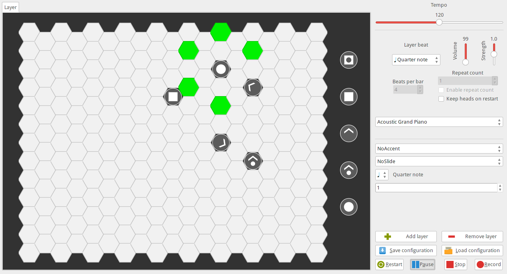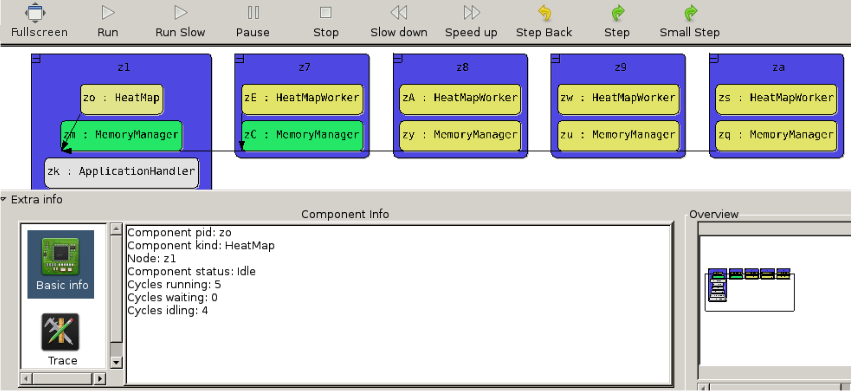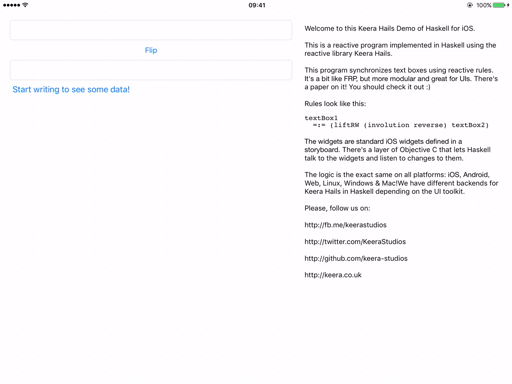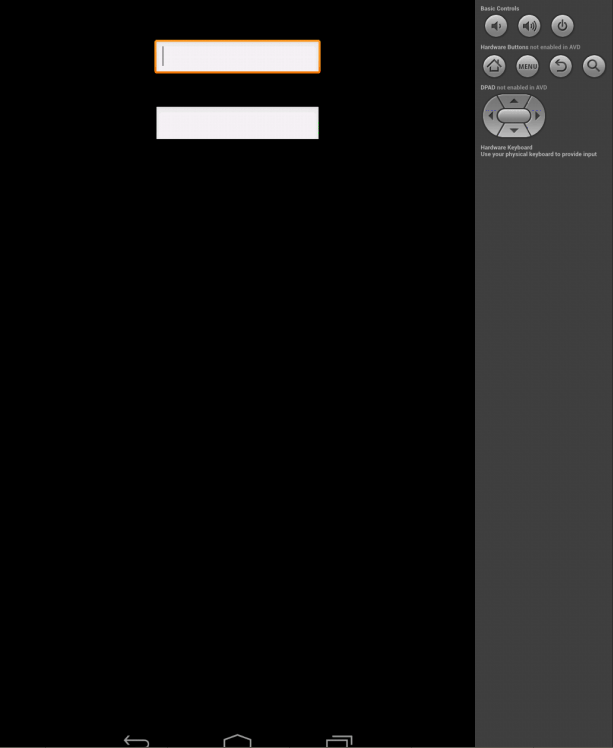Keera Hails is a toolkit to create Reactive Applications in Haskell. It facilitates combining User Interfaces, external devices, network connections, files and, optionally, FRP networks.
Keera Hails is modular and extensible. It is cross platform (Windows, Linux, MacOSX, iOS, Android, GHCJS), UI-agnostic (Gtk+, WX, Qt, iOS native UIs, Android Native toolkit, HTML DOM), FRP-agnostic and device-agnostic (Wiimote, Webcams, etc).
Keera Hails has been used to create large applications and is used commercially in production.
| Image from Gale Studio and Keera Hails demos are Copyright © 2011 - 2022 Keera Studios Ltd. All Rights Reserved. Keera, Keera Studios, Keera Hails, Gale, Gale Studio are trademarks of Keera Studios Ltd. | ||
The two key ideas in Keera Hails are Reactive Values and Reactive Rules. Reactive values are data holders or action endpoints that will contain, provide and/or consume data. Reactive Rules just connect these values so that changes propagate across.
A very simple example of an RV is the following construction, in which a passive
IORef is turned into active Reactive Value.
do
-- Empower IORef with callback installation mechanism. This comes from the
-- keera-callbacks library.
--
-- passiveCBRef :: CBRRef Integer
passiveCBRef <- newCBRef 0
-- Turn IO Ref into active reactive value (RV).
--
-- RVs are type classes. We use the type of Reactive Fields, which have a
-- trivial RV implementation.
let activeCBRefRV :: ReactiveFieldReadWrite IO Integer
activeCBRefRV = ReactiveFieldReadWrite
(writeCBRef passiveCBRef)
(readCBRef passiveCBRef)
(installCallbackCBRef passiveCBRef)We now define an RV that encloses a trivial monadic action:
-- do continues
-- Define a write-only RV that prints whatever you put in it.
let printer :: Show a => ReactiveFieldWrite IO a
printer = wrapMW printYou can connect them together in a monadic environment:
-- Connect them using a reactive rule. In a GUI application, this code would
-- in the controller, and would define connections between the model and
-- the view.
--
-- For bi-directional connections, see (=:=).
activeCBRefRV =:> printerIf you now loop and put data in the IORef, it will be passed along
the reactive connection and printed to the output:
forever $ do
threadDelay 1000000 -- 1 second
reactiveValueModify activeCBRefRV (+1)Using the same, simple ideas, you can define a RVs for, and connect, the fields of GUI widgets, for files, for network sockets, etc.
The toolkit is divided in three parts:
-
Reactive Values: they are typed mutable values with event dispatching and access properties. They can be modified by lifting functions and applying lenses to them. They can also be connected so that they stay in sync during program execution.
- keera-hails-reactivevalues: basic definitions and RV manipulation.
- keera-hails-reactivelenses: lens application.
-
Reactive bindings: Widget properties/attributes can be seen as reactive values. So can network sockets, files, application models ('model' as in MVC) and external resources (polling). Uni-directional, Functional Reactive Programming signal functions can also be wrapped into a pair of RVs (see Yampa). The idea is that, at the highest application level (controller), each layer is wrapped in a reactive container and connected to others.
- keera-hails-reactive-fs: Files as RVs
- keera-hails-reactive-network: Sockets as RVs
- keera-hails-reactive-gtk: Widget attributes and events as RVs
- keera-hails-reactive-wx: Widget attributes and events as RVs
- keera-hails-reactive-qt: Widget attributes and events as RVs
- keera-hails-reactive-htmldom (via GHCJS): HTML DOM element properties as RVs
- keera-hails-reactive-yampa: Yampa reactimation loops as a pair of RVs
- keera-hails-reactive-polling: Strategies to make RVs fire regularly
Backends for iOS and Android (using each platform's native UI toolkits) are also available. Samples can be found here and here. Please contact Keera Studios if you wish to use them.
-
MVC Architecture
MVC is easily applied using hails. There are two easy ways of wraping pure models into RVs, depending on the level of change detection we need to detect and optimise.
- keera-hails-mvc-model-lightmodel: Pure models as RVs
- keera-hails-mvc-model-protectedmodels: Pure models as RVs, with advance change detection. Template Haskell can be used to generate model access RVs based on record fields that stop unnecessary change propagation.
- keera-hails-mvc-view: Interface to the View of any program
- keera-hails-mvc-controller: Simple controller-handling definitions.
A pair Model-View, often needed by the controller, can be wrapped in an environment. The following packages implement a Gtk View and a Gtk environment.
- keera-hails-mvc-view-gtk: Structure to wrap Gtk views.
- keera-hails-mvc-environment-gtk: A MVC triplet based on a Gtk View.
The following package generate default project skeletons that do "the right thing" (currently for Gtk+ only). The application takes the approach of "convention over configuration": certain modules will be expected to have predetermined names. If this is much of a problem, open a bug report.
- keera-hails: Program that generates a project skeleton.
We have a separate README that shows how to build your first app using
keera-hails. -
Applications can be simplified further. The following packages implement Gtk-based choreographies (M-V synchronizations and controller rule templates) and address other common features needed in applications.
- keera-hails-mvc-solutions-gtk: Advanced choreographies for Gtk applications.
- keera-hails-mvc-solutions-config: Handling configuration files cleanly.
- keera-hails-i18n: Handling internationalization
- Building a reactive calculator in Haskell
- The Arpeggigon: Declarative Programming of A Full-Fledged Musical Application (PADL 2017)
- Bridging the GUI gap with reactive values and relations (Haskell Symposium 2015)
- Readme for Reactive Value library
- Ivan Perez's 1st PhD report, pages 29 and 40 (page 40 is a paper of its own; page 29 is the thesis proposal outlining the core ideas and problems that remain to be solved.)
- TFP 2014 Pre-proceedings, pages 59-68
- Reactive Programming using Reactive Values (blog post)
|
Building a reactive calculator in Haskell!
|
For bibtex references to these articles, see Publications in http://www.cs.nott.ac.uk/~ixp/.
- http://github.com/keera-studios/keera-posture
- http://github.com/ivanperez-keera/SoOSiM-ui
- A simple example using RVs for button clicks, sliders, monadic actions and SDL volume
- http://github.com/keera-studios/keera-hails/tree/master/demos/keera-hails-demos-wiimote
- http://github.com/ivanperez-keera/haskellifi-trayicon
- http://github.com/ivanperez-keera/keera-diamondcard-sms-trayicon
I would like to thank the following people for fruitful discussions and collaborations.
- Henrik Nilsson
- Hamish Mackenzie (for helping me create the first GHCJS backend for Hails, and for Gtk2hs).
- Leuite Stegeman (for helping me create the first GHCJS backend for Hails).
- Guerric Chupin (for continuing this work and writing Arpeggigon).
- Arsen Kostenko
- Emilio Gallego
- Paolo Capriotti
- Florent Ballestrieri
- David McGillicuddy
- Philip Holzenspies
- Ian-Woo Kim
- Atze van der Ploeg
- Simon Peyton Jones
- Michał Gajda
- I thank the audiences of the following talks on Reactive programming and
Hails, for patientily listening to me complain about the state of the world
and commenting on my work.
- Haskell Symposium (2015), Vancouver, colocated with ICFP.
- London (2014), Haskell Meetup
- Nottingham (2014), FPLAD.
- TFP (2014)
- FPLab, Nottingham (2013)
- CAES Group, UTwente (2013)
- Babel Research Group, UPM (2010)
(Note: these people do not necessarily support anything I have to say.)





